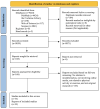Physical Activity Misinformation on Social Media: Systematic Review
- PMID: 41061255
- PMCID: PMC12547344
- DOI: 10.2196/62760
Physical Activity Misinformation on Social Media: Systematic Review
Abstract
Background: Social media is a prominent way in which health information is spread. The accuracy and credibility of such sources range widely, with misleading statements, misreported results of studies, and a lack of references causing health misinformation to become a growing problem. However, previous research on health misinformation related to topics including vaccines, nutrition, and cancer has excluded physical activity despite it being highly searched for and discussed online.
Objective: This systematic review was designed to synthesize the existing literature focused on physical activity misinformation on social media in accordance with PRISMA (Preferred Reporting Items for Systematic Reviews and Meta-Analyses) 2020 guidelines.
Methods: Keyword searches were conducted in PubMed, the Cochrane Library, Web of Science, and Scopus databases for records published between January 2016 and May 2025. This search strategy yielded 9039 articles. Titles and abstracts were screened by independent reviewers, resulting in 168 (1.86%) articles selected for full-text review. After further review, 33 (19.6%) articles met the inclusion criteria and were used in the final synthesis.
Results: For the 33 studies selected, topics included physical rehabilitation and therapeutic exercise recommendations (n=15, 45%), general physical activity and messaging (n=6, 18%), exercising with a specific condition (n=4, 12%), women's health (n=3, 9%), weight loss (n=2, 6%), exercise testing (n=1, 3%), "immune boosting exercise" (n=1, 3%), and workplace sitting versus standing guidelines (n=1, 3%). The social media platforms YouTube (n=13, 39%), TikTok (n=7, 21%), Facebook (n=2, 6%), Instagram (n=1, 3%), and Pinterest (n=1, 3%) were studied, whereas other articles (n=9, 27%) analyzed content that had not explicitly been posted to social media but could be shared widely online. In total, 4 (12%) studies reported research that proactively engaged participants, and the remaining 29 (88%) studies analyzed readily available online content, including social media, news articles, websites, and blogs. Furthermore, 27 (82%) studies reported at least 1 measure of misinformation prevalence, whereas 21 (64%) reported a metric of reach, and 6 (18%) studies reported a measure of misinformation spread.
Conclusions: Our findings indicate that research on social media physical activity misinformation spans a diverse array of physical activity topics, with YouTube being the most studied platform due to its widespread use and ease of content evaluation. This review also highlights the prevalence of low-quality information across various platforms and a lack of longitudinal investigations. Our review underscores the need for multifaceted research approaches and suggests several strategies to combat misinformation, including improved messaging, high-quality information dissemination by institutions, detailed debunking efforts, and raising awareness about misinformation. Future research should focus on understanding the spread of physical activity misinformation across platforms and its impact, especially on vulnerable populations.
Trial registration: PROSPERO CRD42022316101; https://www.crd.york.ac.uk/PROSPERO/view/CRD42022316101.
Keywords: AI; artificial intelligence; digital health; exercise; health misinformation; kinesiology; online content; online misinformation; physical activity; social media; systematic review.
©D David Thomas, Linglin Xu, Brian Yu, Octavio Alanis, John Adamek, Imani Canton, Xuan Lin, Yan Luo, Sean P Mullen. Originally published in JMIR Infodemiology (https://infodemiology.jmir.org), 08.10.2025.
Conflict of interest statement
Conflicts of Interest: None declared.
Figures
References
-
- Jacobs W, Amuta AO, Jeon KC. Health information seeking in the digital age: an analysis of health information seeking behavior among US adults. Cogent Soc Sci. 2017 Mar 13;3(1):1302785. doi: 10.1080/23311886.2017.1302785. - DOI
-
- Krishna A, Thompson TL. Misinformation about health: a review of health communication and misinformation scholarship. Am Behav Sci. 2019 Sep 27;65(2):316–32. doi: 10.1177/0002764219878223. - DOI
Publication types
MeSH terms
LinkOut - more resources
Full Text Sources
Medical
Miscellaneous


